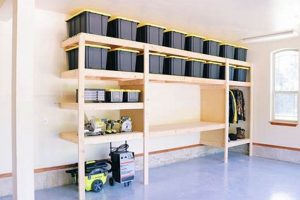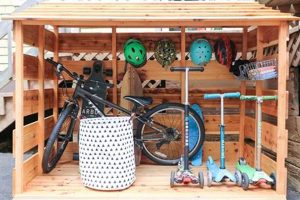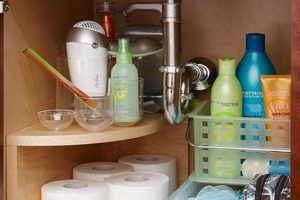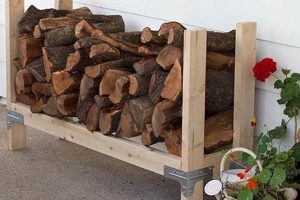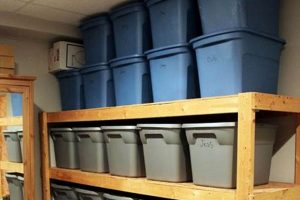The concept involves constructing receptacles or enclosures designed to conceal and organize refuse containers. These solutions are often built from readily available materials using basic tools, enabling customized adaptations to various spaces and aesthetic preferences. A common example includes building a wooden structure to house outdoor garbage bins, thereby improving curb appeal and preventing animal access.
Implementing such solutions yields several advantages. It enhances property aesthetics by concealing unsightly bins. Furthermore, it provides a degree of protection against the elements and potential disruption from wildlife. Historically, the need for effective waste management has prompted innovations in storage methods, with do-it-yourself options offering a cost-effective and adaptable approach for homeowners.
The subsequent sections will delve into specific design ideas, material selection considerations, and step-by-step construction guidance for creating personalized waste container solutions.
Tips for Effective Waste Container Concealment
The following suggestions are intended to guide the design and construction of durable and aesthetically pleasing structures for concealing refuse containers.
Tip 1: Material Selection is Critical: Opt for weather-resistant materials such as treated lumber, composite decking, or durable plastics. This minimizes degradation from environmental exposure and prolongs the lifespan of the enclosure.
Tip 2: Prioritize Accessibility: Design the structure with easily accessible doors or lids to facilitate convenient disposal and removal of waste containers. Ensure sufficient clearance for container maneuverability.
Tip 3: Incorporate Ventilation: Proper ventilation reduces moisture buildup and minimizes unpleasant odors. Consider incorporating vents or gaps in the design to promote airflow.
Tip 4: Secure the Structure: Anchor the enclosure to a solid foundation or the ground, especially in areas prone to high winds. This prevents displacement and potential damage.
Tip 5: Consider Aesthetic Integration: Match the style and color of the enclosure to the existing architecture and landscaping. This creates a cohesive and visually appealing appearance.
Tip 6: Plan for Container Size: Accurately measure the dimensions of the waste containers to ensure a proper fit within the enclosure. Allow extra space for easy removal and replacement.
Tip 7: Utilize Locking Mechanisms: Incorporate locking mechanisms to prevent unauthorized access and discourage animal intrusion. This is especially important in areas with wildlife.
Tip 8: Regular Maintenance is Key: Periodically inspect and maintain the enclosure to ensure its structural integrity and aesthetic appeal. Repair any damage promptly to prevent further deterioration.
By following these tips, individuals can construct effective and visually appealing waste container solutions that enhance property value and improve waste management practices.
The subsequent section will address frequently asked questions regarding the design and implementation of these storage solutions.
1. Concealment
Concealment forms a foundational element of effective waste container solutions. The visual impact of exposed refuse containers can detract significantly from property aesthetics and overall curb appeal. Consequently, the ability to effectively obscure these utilitarian objects represents a primary motivator for the construction of do-it-yourself waste container structures. The cause-and-effect relationship is straightforward: visible refuse containers lead to diminished aesthetic value, which prompts the development of concealment strategies. A practical example involves the construction of a simple wooden enclosure to shield garbage bins from public view, transforming a potential eyesore into an unobtrusive structure.
The importance of concealment extends beyond mere aesthetics. In some residential areas, homeowners’ associations (HOAs) may mandate that refuse containers be screened from view. Failure to comply with such regulations can result in fines or other penalties. Furthermore, concealing waste containers can deter scavenging animals, thereby mitigating the risk of property damage and the spread of disease. The practical application of this understanding involves incorporating design features, such as solid walls and secure lids, to minimize visual and olfactory cues that might attract unwanted attention. For example, surrounding a trash can with a high fence can make a big impact.
In summary, the strategic implementation of concealment measures is paramount to realizing the full benefits of waste container storage solutions. While aesthetic considerations are important, the practical advantages, including regulatory compliance and pest control, are equally compelling. Challenges may include balancing the need for concealment with the need for accessibility and ventilation. Addressing these challenges effectively ensures that do-it-yourself waste container solutions not only enhance property value but also contribute to a cleaner and more hygienic environment.
2. Accessibility
Accessibility represents a critical design consideration in the context of do-it-yourself waste container solutions. Effective refuse management necessitates convenient and unimpeded access to both deposit waste and remove filled containers. Consequently, incorporating accessibility features is essential for maximizing the utility and practicality of such structures.
- Lid Operation Mechanisms
The design of lids and doors significantly impacts the ease of use. Hinged lids, sliding doors, or removable tops each offer distinct advantages and disadvantages. The selection should align with user strength and mobility. For example, heavy lids may require counterbalance mechanisms or assisted-lift hardware to mitigate strain. Insufficient clearance around the opening may impede the effortless disposal of garbage. Consideration of ergonomic factors ensures that users of all physical abilities can easily operate the enclosure.
- Container Removal Clearance
Sufficient space must be allocated within the enclosure to facilitate the removal of waste containers, particularly when full. Constricted spaces can lead to spillage, damage to the enclosure, and potential injury. Furthermore, the presence of obstacles, such as narrow doorways or low ceilings, can complicate the removal process. A well-designed structure incorporates ample clearance to allow for smooth and safe container extraction, even when containers are at maximum capacity.
- Pathways and Obstructions
The route leading to and from the waste container enclosure must be free of obstructions and designed with accessibility in mind. Uneven surfaces, steep inclines, or narrow pathways can pose challenges for users, especially when transporting heavy containers. Considerations should include the use of ramps, paved surfaces, and adequate lighting to ensure safe and convenient access, regardless of weather conditions or time of day.
- Maintenance Access
Accessibility extends beyond routine waste disposal; it also encompasses the ease with which the enclosure can be maintained. Hinged panels or removable sections facilitate cleaning, repairs, and pest control. Difficult-to-reach areas can accumulate debris and harbor pests, leading to unsanitary conditions and structural damage. A design that prioritizes maintenance access ensures the longevity and hygiene of the waste container solution.
These facets of accessibility collectively contribute to a user-friendly and efficient waste management system. A do-it-yourself waste container solution that fails to address these considerations may ultimately prove impractical and ineffective, undermining its intended purpose. Incorporating these elements increases the value of the project and creates something very efficient for all to use.
3. Material durability
Material durability is a primary determinant of the long-term viability and cost-effectiveness of do-it-yourself waste container structures. The selection of appropriate materials directly influences the enclosure’s resistance to environmental stressors, physical damage, and pest infestations, ultimately impacting its lifespan and maintenance requirements. This connection is therefore critical for the project.
- Weather Resistance
Outdoor waste container enclosures are constantly exposed to the elements, including sunlight, rain, snow, and temperature fluctuations. Materials lacking inherent weather resistance, such as untreated wood, are susceptible to rot, warping, and cracking. Conversely, materials like treated lumber, composite decking, or certain plastics exhibit superior resistance to these factors, ensuring structural integrity over extended periods. For example, using pressure-treated lumber significantly extends the lifespan of a wooden enclosure compared to using untreated pine.
- Impact Resistance
Refuse containers are subject to physical impacts during loading, unloading, and handling. Materials prone to cracking or denting compromise the enclosure’s structural integrity and aesthetic appeal. Durable materials, such as reinforced plastics or metal sheeting, offer greater resistance to impact damage. A common example is the use of metal corner guards to protect vulnerable edges from accidental collisions.
- Pest Resistance
Waste containers often attract pests, including rodents and insects. Materials that are easily gnawed or burrowed into provide entry points for these organisms, leading to unsanitary conditions and potential structural damage. Pest-resistant materials, such as metal or certain types of treated wood, prevent infestation and maintain the enclosure’s integrity. For example, using hardware cloth to line the interior of a wooden enclosure can deter rodents from chewing through the wood.
- Resistance to Decay
Decay or corrosion, influenced by environmental exposure and material properties, must be considered. Materials susceptible to rust or rotting can degrade over time. Durable materials such as metals with protective coatings or rot-resistant wood are preferred. For instance, a wooden enclosure coated with sealant can last for decades.
The selection of appropriate, durable materials represents a fundamental aspect of constructing effective waste container solutions. Careful consideration of weather resistance, impact resistance, and pest resistance ensures that the enclosure provides long-term protection, maintains its aesthetic appeal, and minimizes maintenance requirements. This contributes to a sustainable and cost-effective waste management system and it is imperative to choose long-lasting materials to avoid maintenance.
4. Aesthetic Integration
Aesthetic integration, in the context of do-it-yourself refuse container structures, concerns the harmonious blending of the enclosure’s design with its surrounding environment. The failure to achieve this integration results in a visually discordant element that detracts from the property’s overall appearance. Conversely, successful aesthetic integration elevates the functional structure into a complementary feature of the landscape or architectural design. This is the cause-and-effect relationship. For example, a refuse container enclosure constructed from repurposed materials that mirror the style and color palette of an existing fence line demonstrates effective aesthetic integration.
The importance of aesthetic integration stems from its direct impact on property value and curb appeal. A well-designed enclosure, seamlessly integrated into its surroundings, enhances the visual coherence of the property, creating a more pleasing and inviting impression. Conversely, a poorly designed or inappropriately colored enclosure can create a negative visual impact, diminishing the property’s overall attractiveness. The practical significance of this understanding is evident in the increasing prevalence of homeowners’ associations (HOAs) mandating specific design guidelines for refuse container enclosures, aimed at preserving the aesthetic integrity of the neighborhood. Another example is an outdoor cabinet that stores the trash cans but has the same color and material as your backyard fence, making it a part of the background instead of something sticking out.
In conclusion, aesthetic integration represents a critical component of successful do-it-yourself refuse container solutions. While functional considerations, such as accessibility and durability, remain paramount, the visual impact of the enclosure cannot be overlooked. Addressing the challenges of achieving seamless integration requires careful attention to material selection, color coordination, and overall design coherence. By prioritizing aesthetic integration, individuals can transform a utilitarian necessity into an asset that enhances property value and elevates the visual appeal of the surrounding environment.
5. Space optimization
Space optimization, in relation to do-it-yourself refuse container solutions, involves the strategic and efficient use of available area to house waste containers while minimizing the footprint of the enclosure. The failure to optimize space results in unnecessary encroachment on usable areas, potentially hindering movement and reducing the overall functionality of the environment. Conversely, successful space optimization maximizes the enclosure’s storage capacity without compromising surrounding space, resulting in a more practical and aesthetically pleasing waste management system. The cause-and-effect relationship is that poorly planned trash storage takes up more room, which prompts the design of more efficient structures. A real-life example involves designing a vertical enclosure that stacks containers, thereby reducing the horizontal space occupied by the structure.
The importance of space optimization stems from its direct impact on usability and property value, particularly in densely populated areas or smaller properties where space is at a premium. A well-designed, space-efficient enclosure allows for the storage of multiple refuse containers without sacrificing valuable yard space or impeding access to other areas of the property. The practical significance of this understanding is evident in the development of innovative designs that incorporate features such as sliding doors, fold-down shelves, or integrated recycling compartments, each aimed at maximizing storage capacity within a minimal footprint. For example, utilizing the space above the containers for storage can be a huge space saver.
In summary, space optimization represents a crucial element in the successful implementation of do-it-yourself waste container solutions. Functional concerns, such as accessibility and material durability, need to be balanced with efficient space use. Addressing the challenges of achieving optimal space utilization requires careful attention to design principles, storage needs, and the specific constraints of the available area. Focusing on space optimization transforms a utilitarian necessity into an asset that enhances functionality and improves property utilization.
6. Animal deterrent
Animal deterrence represents a crucial consideration in the design and implementation of do-it-yourself refuse container solutions. The presence of accessible waste attracts various animals, potentially resulting in property damage, unsanitary conditions, and the spread of disease. Consequently, the integration of animal deterrent measures constitutes a fundamental component of effective waste management. The cause-and-effect relationship is clear: accessible waste containers attract animals, which necessitates the implementation of deterrent strategies. An enclosure with a tightly sealed door and a locking mechanism is an example of these strategies.
The importance of animal deterrence stems from its direct impact on public health and safety, as well as property maintenance costs. A well-designed enclosure effectively prevents animals from accessing refuse, minimizing the risk of scavenging, scattering waste, and damaging property. The practical significance of this understanding is evident in areas with high wildlife populations, where homeowners often face ongoing challenges related to animal intrusion into garbage cans. Implementing measures such as secure lids, reinforced construction materials, and elevated platforms can significantly reduce the incidence of animal-related problems. For instance, in bear-prone areas, specialized bear-resistant enclosures are often necessary to effectively deter these powerful animals.
In summary, animal deterrence is an essential element of successful do-it-yourself waste container solutions. Though functional considerations like space optimization and accessibility are paramount, the need to prevent animal access is equally important. Addressing the challenges of building animal-resistant enclosures requires careful attention to design, materials, and closure mechanisms. Prioritizing animal deterrence transforms a standard waste receptacle into an ecosystem-conscious solution, enhancing environmental and community health.
Frequently Asked Questions
The subsequent questions address common concerns and provide clarification regarding the design, construction, and maintenance of do-it-yourself refuse container solutions.
Question 1: What is the optimal material for constructing an outdoor trash can enclosure in a region with harsh winters?
Treated lumber or composite decking is generally recommended. These materials exhibit superior resistance to moisture, temperature fluctuations, and freeze-thaw cycles, minimizing warping, cracking, and rot.
Question 2: How can sufficient ventilation be ensured within a trash can enclosure to minimize odors?
Incorporating ventilation openings, such as screened vents or spaced slats, allows for airflow and reduces moisture buildup. The placement and size of these openings should be carefully considered to balance ventilation with pest control.
Question 3: What strategies can be employed to deter rodents from accessing a trash can enclosure?
Lining the interior with hardware cloth, using tightly sealed lids, and elevating the enclosure on a concrete base are effective deterrents. Regularly cleaning the enclosure to remove food residue further reduces rodent attraction.
Question 4: How should the size of a trash can enclosure be determined?
Accurately measure the dimensions of the trash cans, including height, width, and depth. Add several inches of clearance on all sides to facilitate easy removal and replacement of the containers.
Question 5: What is the recommended method for securing a trash can enclosure to prevent tipping in high winds?
Anchoring the enclosure to a concrete slab or using ground anchors provides stability. The specific anchoring method will depend on the size and weight of the structure, as well as the prevailing wind conditions.
Question 6: How often should a trash can enclosure be cleaned and maintained?
Regular cleaning, at least monthly, is recommended to remove debris and prevent odor buildup. Inspect the structure periodically for damage and promptly repair any cracks, rot, or loose hardware.
These FAQs provide essential guidance for designing and maintaining effective refuse container solutions. Proper material selection, ventilation, pest control, sizing, anchoring, and maintenance are all critical factors for long-term performance.
The next segment will summarize the essential topics of this resource.
In Conclusion
The preceding discussion has explored the multifaceted considerations involved in the design and implementation of “diy trash can storage” solutions. Key aspects highlighted include the importance of concealment, accessibility, material durability, aesthetic integration, space optimization, and animal deterrence. Each element contributes to the functionality, longevity, and overall value of the waste management system.
The creation of personalized waste container solutions presents an opportunity to enhance property value, improve waste management practices, and contribute to environmental stewardship. The successful application of these principles requires careful planning, informed material selection, and a commitment to ongoing maintenance. Embracing this approach is more than a simple do-it-yourself project; it is an investment in a cleaner and more sustainable living environment.


![Build Your Own! Storage Bin Rack DIY Project [Easy] The DIY Hub: Creative Crafts, Repairs & Life Hacks Build Your Own! Storage Bin Rack DIY Project [Easy] | The DIY Hub: Creative Crafts, Repairs & Life Hacks](https://craftingdiycenter.com/wp-content/uploads/2025/07/th-1825-300x200.jpg)
